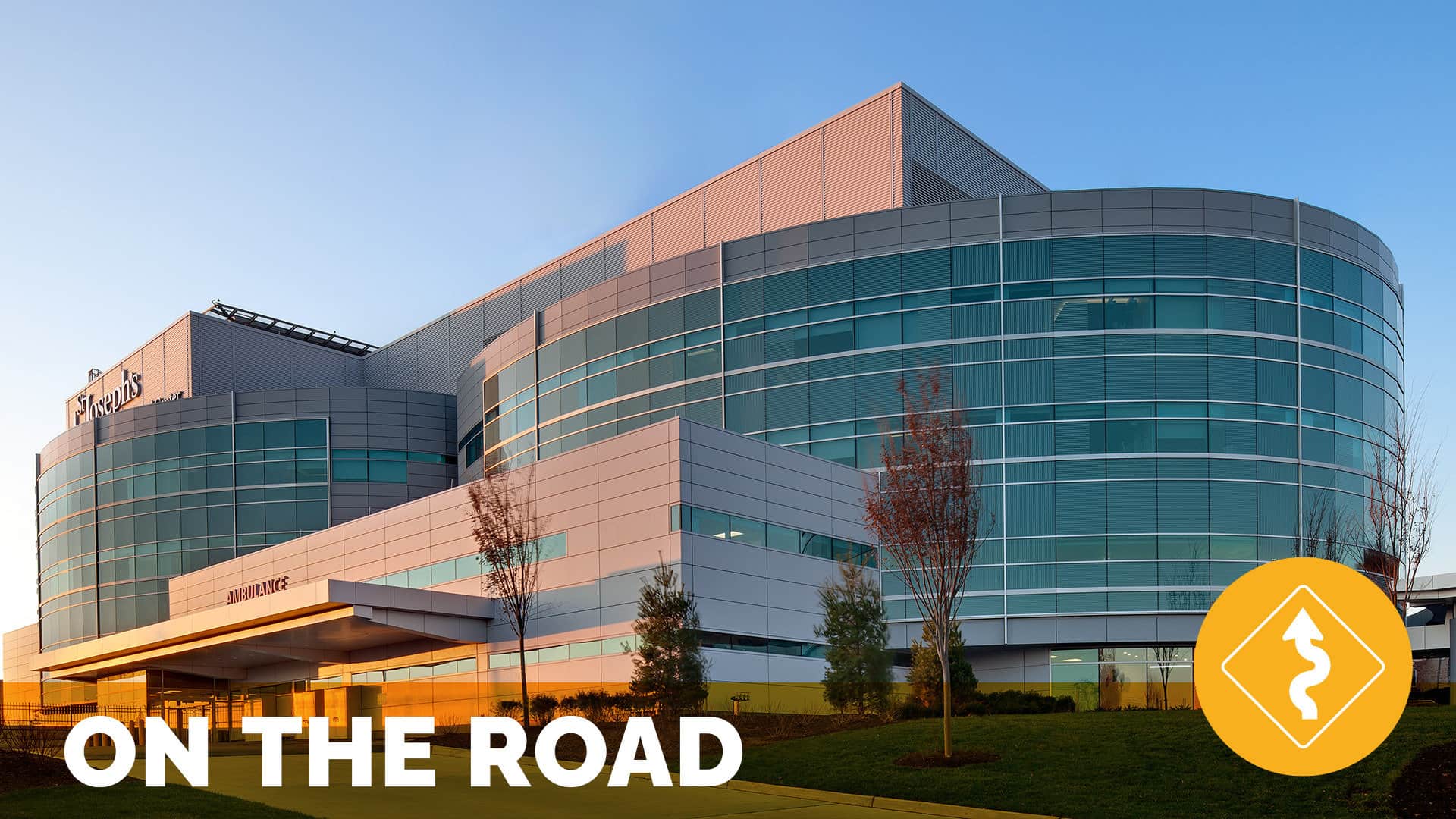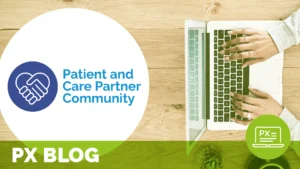A Healthcare System Woven into the Community it Serves: Returning to the Place of My First Patient Experience

On the Road with St. Joseph’s Health – Wayne/Paterson, NJ – May 2019
by Jason A. Wolf, PhD, CPXP
A Cornerstone of Compassion
Our latest On the Road presented a profound opportunity for me. Not only is St. Joseph’s Health and its flagship St. Joseph’s University Medical Center housed in one of the most diverse communities in the United States and grounded unequivocally in a purpose to serve others above all else, but also it has a very personal connection for me. St. Joseph’s was the place of my first patient experience, where I entered the world almost 50 years ago.
There is something both profound and cathartic when you find yourself walking the halls of a place in which you took your first breath. What is perhaps more moving is when you come to see through the people who work every day to serve their community, the true commitment to caring for others with no biases about background or means, but as a human beings deserving of the care they need. It was palpable as I met the people of St. Joseph’s and walked its halls, that the connection I felt went beyond the clinical encounter I first had to the very values that are the mortar of this great organization.
Located in the heart of Paterson, NJ, St. Joseph’s Health represents community hospital meets safety net, and social enterprise meets social developer. What I saw in my time here was not just a commitment to excellence and innovation, but one of a commitment to the community it has had the honor to call home for over 150 years. While I will not share the full history of St. Joseph’s it is worth reviewing and also noting it is the roots from where it came that still drives its mission today . As the team at St. Joseph’s exemplified, their mission was not simply words on a page, but a way of being that permeated all I had the chance to see. With the mission “to provide exceptional quality care which sustains and improves both individual and community health, with a special concern for those who are poor, vulnerable and underserved,” you can already get a sense of the special place St. Joseph’s is.
It is with this perspective that I had the chance to interact with the people and patients of St. Joseph’s, experience their processes and programs and observe their commitment to improvement. This was exemplified by the first stop of my visit, participating in the monthly meeting of their Organizational Patient Experience Improvement Committee (OXIC), as they addressed their current opportunities.
A Commitment to Improvement
OXIC, comprised of representatives of various units across the system, represents a clear and powerful commitment to experience improvement. This standing committee, representing one of the major priorities identified by the St. Joseph’s Board of Trustees, meets monthly to share patient stories, review key metrics and share practical and evidence-based cases on improvement efforts that have the potential for replication and spread in the organization. It has structured its work around moving the needle on three key drivers – communication, courtesy and respect, and listening/responsiveness – and three subgroups have been aligned to tackle these items.
In the May meeting two patient stories were shared, one about a security guard who went out of his way to help a family member who was at the hospital having car problems. The generosity of spirit and caring exemplified in the actions this individual took had the patient dub the security guard her “hero” and said “that was the first time I ever felt anyone helped me in this way”. This was followed by a powerful story of a patient living with dementia who was trying to leave her unit. She was unhappy, confused, unsure and unsettled in her surroundings so the staff worked to make her feel at home. The team helped this patient with simple things, such as helping get her hair done, something she was truly wanting to do. They recognized the individual as the human she was and provided the dignity she deserved. It changed the entire experience for that patient and her family.
I share these summaries as it was the true essence of these stories that I encountered on the remainder of my visit. They exemplify a true sense of caring for more than a diagnosis or disease, to a caring for the whole person and a going the extra step. These ideas were reinforced in the cases also presented during the OXIC meeting which addressed two powerful practice models that were tested and validated at St. Joseph’s.
The first case was focused on leadership rounding. It was a case that shared a clear process of communication, modeling behavior and ensuring responsiveness. By building in a process for measured and consistent action, the team was able to show significant improvement across a number of CAHPS questions. They framed an intervention that addressed core but critical items such as:
- Was the whiteboard updated?
- Do you know the name of your nurse?
- Has the staff followed up in a reasonable timeframe?
- Is there one thing we could improve on?
- Is there anyone I should recognize?
By asking these questions the team was able to act more immediately, providing feedback instantly and making the necessary changes in the moment in response to identified needs. As a result of this effort, 25 of 34 metrics saw increases. At the same time a significant reduction in call bells was realized, freeing the staff to focus on their core duties and spend more time with their patients.
The second case turned from attentiveness to patient and family needs to those of the nursing workforce. In a great synopsis of her doctoral research, Patricia Drabik, Director of Nursing at St. Joseph’s Wayne Medical Center, was able to show the positive impact of recognition via hand written notes to staff members, namely the nursing staff. In her research, Drabik discovered the desire for recognition and the value it had specifically if delivered in a private, personal and connected way. In creating a structured framework for recognition, the opportunity to reignite a nurse’s passion for the profession was recognized. I hope we can share more on this study and the previous case via the Institute in the months ahead.
What the OXIC exemplifies is what is possible when you take a system level view of experience excellence by sharing stories, elevating cases and engaging a broad range of voices, then match it with a willingness to take action. This combination of governance and guidance blended with focused and accountable leadership provide a powerful combination to ensure focused and sustained efforts for improvement. I look forward to following the work of the OXIC as it continues its journey.
A Place for Community and Returning Home
As part of my visit, I had the opportunity to walk the halls of St. Joseph’s at both their Wayne campus and main campus in downtown Paterson. What I immediately noticed was the consistent sense of welcome everyone you encountered portrayed. You didn’t feel like a stranger at St. Joseph’s, in fact it felt more like being welcomed home. I will have to own that for me it was a coming home of sorts, to the healthcare organization and hospital in which I was born. But in having the chance to walk the halls, observe the interactions and gauge the energy, this was not just a feeling I was having. It was living in the very fiber of St. Joseph’s.
My rounding tour took me to many corners of both campuses and a few highlights to share. In Wayne I had the chance to experience a number of great units from radiology to rehab. A few great practices were shared that were designed to better connect the staff and patient and families with the process. On the Acute Rehab Unit in particular, an effort to provide more than discharge information by moving to a model of patient education provided a means to ensure consistent communication between team members and those they care for. Patient Education Baskets have been placed in each patient room to ensure needed information is identified and shared in a timely manner. This means to easily transfer information and knowledge is meant to both better educate patients and family members while ensuring consistency in communication between staff as well.
St. Joseph’s is also on a High Reliability journey and it was great to see parts of this process show up on the walls of the facility in Wayne as well. In particular the idea of “Who is your picture person?” (i.e., or who do you do this work for?). The pictures on the wall brought a powerful humanity to the care environment and also allowed people to both state and elevate their purpose for wanting to care for others. This is a tangible and palpable means to truly highlight and elevate the human experience in healthcare.
My touring continued on St. Joseph’s main campus in Paterson and, while I had a chance to see much of the organization, there are three places I’d like to share more from my visit. First, our visit to the behavioral health unit exemplified the power of dignity in action. What was once a dark and sullen unit overshadowed by the stigma of mental health was refreshed, lightened (literally with new paint and lighting) and reignited as a place that found the person at the heart of the disease of mental health. It honored the people they cared for and provided a comfortable and safe environment in which to get care. In fact, in focusing on the people they served and engaging them as people not problems, the staff has been able to change the overall nature of care in so much that they have been a restraint-free environment now for over three years.
I too was able to spend time in the St. Joseph’s University Medical Center Emergency Department, the third largest ED in the United States and one that even in its scope and scale provided a powerful sense of logic and calm. Patient flows were clear and processes in place, and more so a commitment to keeping people from waiting and into care was a top priority. With the sheer volume of cases that present at the ED, around 400 per day, the waiting room was almost empty, the staff welcoming and the environment calm. Part of this was due to the coordination the ED team has with the community it serves. Dr. Marianna Karounos, Chief of the Department of Emergency Medicine, conveyed that in having a tight connection to the community the team could anticipate versus react to the needs that come their way. This was an ED staying ahead of its waves versus trying to brace themselves for when they arrived. They also have worked on special efforts such as establishing the first accredited Geriatric Emergency Department in New Jersey, serving as a central critical care center for the region and developing a significant and foundational effort focused on the reduction of opioid use – the ALTO Program (Alternatives to Opioids®) – led by Dr. Mark Rosenberg, DO, MBA, FACEP, FAAHPM, Chairman of Emergency Medicine. The ALTO program has led to landmark national legislation in the United States and a created a true, proven and evidence-based path to reduction in opioid use.
While I had the chance to visit with a few other units all doing incredible work to lead the experience effort for St. Joseph’s, I will end the reflections on my tour at the Mother Baby Unit. This unit was actually the location for the initial case study on leadership rounding shared during the morning’s OXIC meeting and a was a bustling center of activity. For me the moment was profound as while not the exact physical location of my birth, the roots of this unit and many of the folks who helped this current team grow in their current careers were the ones that helped with my birth at St. Joseph’s. In fact the very spirit of St. Joseph’s emanated from both the faces and words of the team hard at work caring for families of all backgrounds and ethnicities all coming here for something magical, bring a new life into the world. The team was gracious in welcoming me home, but also in sharing stories that underlined the very foundations on which St. Joseph’s was founded, and for some reason I believe became part of my own DNA.
They shared a story of a patient who was brought to St. Joseph’s by a friend because she was told they will take care of you there. Pregnant, poor and alone was the way this individual was described who had her baby at St. Joseph’s having no insurance, no means to pay for the medications she needed and no way to even get her and her baby home when it was time to leave. The team kicked in, making arrangements to ensure she had the medicines she needed, getting appropriate clothes for the baby and ensuring safe transportation as she took the baby home. It was a team effort driven on the idea that at St. Joseph’s they are committed to care first, and as noted above, they act with “a special concern for those who are poor, vulnerable and underserved.” “This is not just a nice thing we do here,” said one of the nurses, “It is who we are.” That is powerful and not something you create overnight. It is a tradition that comes with over a century of care with a purpose, a purpose that was perhaps ingrained in me now five decades ago as well.
It was powerful to go home, to stand where you first took a breath, to know that it was people like the very ones I had the chance to listen to, shake the hands of and receive welcoming hugs from people who frame the legacy of St. Joseph’s. I am grateful for the welcome, and I was moved by the opportunity to return. What I found in the actions of the team in Mother Baby and Labor and Delivery and in the many stories they had to share was all that is right and good about healthcare. This idea of what is right and good is at the very heart of what St. Joseph’s Health is all about and it was reinforced with vigor by the leaders of the organization I had the chance to meet.
The Fabric of St Joseph’s: Grounded in Purpose
During my visit, I was honored to spend time with a number of members from the leadership and executive team of St. Joseph’s as well. I will say that this does not always happen during my On the Road visits and definitely not to the scale of the conversation we had that afternoon in Paterson. The passion and purpose underlined by the group was clear and I could spend an entire new article just sharing their words. But to give you a flavor of what these inspired and inspiring leaders shared, they in essence summarized the true spirit of St. Joseph’s. And, in asking what it was about St. Joseph’s that stood out for them as leaders, the answers were loud and clear.
It’s about the people. Lisa Brady, SVP, COO, shared that people who come here see the commitment and engagement of the long tenured staff and “catch the gift” of what it means to work here. Kenneth M. Morris, Jr., Vice President for External Affairs, shared that people choose St. Joseph’s not for the money they will make, but for the mission they will serve. Debbie Smith, Executive Director of Nursing, shared, “People don’t need to carry their values on a card here, we live them every day.”
It’s about the community. Sister Fran Raftery shared the power of the history of St. Joseph’s and its roots in charity. She offered, “The community realizes what we do, to serve the poor. To know what it means to have nothing, but be treated as something, as a person.” Kevin J. Slavin, President and CEO, talked about the practical actions they take at St. Joseph’s to give back to the community in tangible and measurable ways.
It’s about more than healthcare.
This commitment at the leadership level was mirrored in all that echoed through every hall I walked and in every encounter I had. It was truly a committed family of people, committed to the people they served regardless of status or means, and an organization woven into the very fabric of the community they served.
There is probably so much more I could and should say as in any On the Road but what must be said is that there is a special place hidden in Paterson, NJ called St. Joseph’s Health. It is a place of innovation, and as President and CEO Kevin J. Slavin reinforced, “a place of firsts”. It is a place of gracious charity, deep history and broad compassion and I must add it is a place I am proud to call home. So yes, perhaps I am biased, but I would hope we could all be as proud of the place we were born knowing that in the world of healthcare there is so much good happening, and we must do all we can to elevate it.
As we wrapped up, Tom Casey shared there is something about the people here, which led us to a simple statement generated by one of our community members. The magic of St. Joseph’s is what is inside its people, and as they say, “It’s what’s inside us!” I was honored to be invited back and humbled to know that I have a little piece of St. Joseph’s inside of me. Perhaps it is why I love this work and all we do within The Beryl Institute community together. I will remain forever inspired by what each and every one of you do to create places like St. Joseph’s and so many more. Places that care for others and for one another. That is ultimately elevating the human experience in healthcare, and we must never relent.
Related content
-
 Patient Family & Community Engagement
Patient Family & Community EngagementHope for Healthcare
Members of The Beryl Institute’s Global Patient and Family Advisory Board wish you happy holidays. As 2024 draws to a close, we asked our members to jot down their hopes for healthcare as we welcome the upcoming new year. Tony Serge: My hope for healthcare is for leadership, providers, and staff to work together with
Learn more -
 Environment & Hospitality | Infrastructure & Governance
Environment & Hospitality | Infrastructure & GovernanceBut We’ve Always Done It That Way: Using SWOT to Enhance Your Volunteer Program
It’s easy to fall into a routine in Volunteer Services. But what if you could get free help to elevate your program and team? Learn how to conduct an effective SWOT analysis and gain valuable insight to help keep you at the top of your game. Alex Seblatnigg, CAVS, CPXP | Director of Volunteer Services
Learn more -
 Patient Family & Community Engagement
Patient Family & Community EngagementWe’re all patients, or we’re about to be
Jason Wolf, President and CEO of The Beryl Institute, speaks with Jennifer Bright, MPA, President of the International Consortium for Health Outcomes Measurement (ICHOM). In this insightful conversation, Jennifer shares her personal journey and passion for transforming healthcare. Together, they explore the vital role of patient centricity and why embracing a global perspective is essential
Learn more
